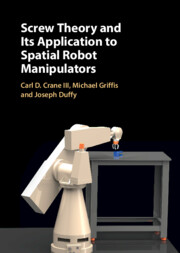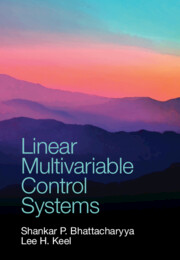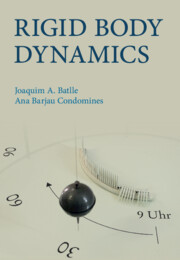Refine search
Actions for selected content:
2002 results in Engineering design, kinematics, and robotics

Screw Theory and its Application to Spatial Robot Manipulators
-
- Published online:
- 08 September 2022
- Print publication:
- 15 September 2022

Linear Multivariable Control Systems
-
- Published online:
- 02 June 2022
- Print publication:
- 13 January 2022
-
- Textbook
- Export citation
1 - Particle Dynamics
-
- Book:
- Rigid Body Dynamics
- Published online:
- 21 March 2022
- Print publication:
- 14 April 2022, pp 1-78
-
- Chapter
- Export citation
Preface
-
- Book:
- Rigid Body Dynamics
- Published online:
- 21 March 2022
- Print publication:
- 14 April 2022, pp ix-xi
-
- Chapter
- Export citation
7 - Lagrange’s Equations
-
- Book:
- Rigid Body Dynamics
- Published online:
- 21 March 2022
- Print publication:
- 14 April 2022, pp 463-503
-
- Chapter
- Export citation
Abbreviations
-
- Book:
- Rigid Body Dynamics
- Published online:
- 21 March 2022
- Print publication:
- 14 April 2022, pp xii-xii
-
- Chapter
- Export citation
Bibliography
-
- Book:
- Rigid Body Dynamics
- Published online:
- 21 March 2022
- Print publication:
- 14 April 2022, pp 579-579
-
- Chapter
- Export citation
Reviews
-
- Book:
- Rigid Body Dynamics
- Published online:
- 21 March 2022
- Print publication:
- 14 April 2022, pp ii-ii
-
- Chapter
- Export citation
Further Reading
-
- Book:
- Rigid Body Dynamics
- Published online:
- 21 March 2022
- Print publication:
- 14 April 2022, pp 579-579
-
- Chapter
- Export citation
5 - Work–Energy Theorem
-
- Book:
- Rigid Body Dynamics
- Published online:
- 21 March 2022
- Print publication:
- 14 April 2022, pp 316-405
-
- Chapter
- Export citation
8 - Introduction to Percussive Dynamics
-
- Book:
- Rigid Body Dynamics
- Published online:
- 21 March 2022
- Print publication:
- 14 April 2022, pp 504-578
-
- Chapter
- Export citation
2 - Interaction Forces between Rigid Bodies
-
- Book:
- Rigid Body Dynamics
- Published online:
- 21 March 2022
- Print publication:
- 14 April 2022, pp 79-150
-
- Chapter
- Export citation
4 - Vector Theorems
-
- Book:
- Rigid Body Dynamics
- Published online:
- 21 March 2022
- Print publication:
- 14 April 2022, pp 202-315
-
- Chapter
- Export citation
Contents
-
- Book:
- Rigid Body Dynamics
- Published online:
- 21 March 2022
- Print publication:
- 14 April 2022, pp v-viii
-
- Chapter
- Export citation
6 - The Method of Virtual Power
-
- Book:
- Rigid Body Dynamics
- Published online:
- 21 March 2022
- Print publication:
- 14 April 2022, pp 406-462
-
- Chapter
- Export citation
Index
-
- Book:
- Rigid Body Dynamics
- Published online:
- 21 March 2022
- Print publication:
- 14 April 2022, pp 580-584
-
- Chapter
- Export citation
3 - Mass Distribution
-
- Book:
- Rigid Body Dynamics
- Published online:
- 21 March 2022
- Print publication:
- 14 April 2022, pp 151-201
-
- Chapter
- Export citation
Copyright page
-
- Book:
- Rigid Body Dynamics
- Published online:
- 21 March 2022
- Print publication:
- 14 April 2022, pp iv-iv
-
- Chapter
- Export citation

Rigid Body Dynamics
-
- Published online:
- 21 March 2022
- Print publication:
- 14 April 2022
7 - Generic Frameworks
- from Part I - The General Case
-
- Book:
- Frameworks, Tensegrities, and Symmetry
- Published online:
- 13 January 2022
- Print publication:
- 27 January 2022, pp 135-154
-
- Chapter
- Export citation
